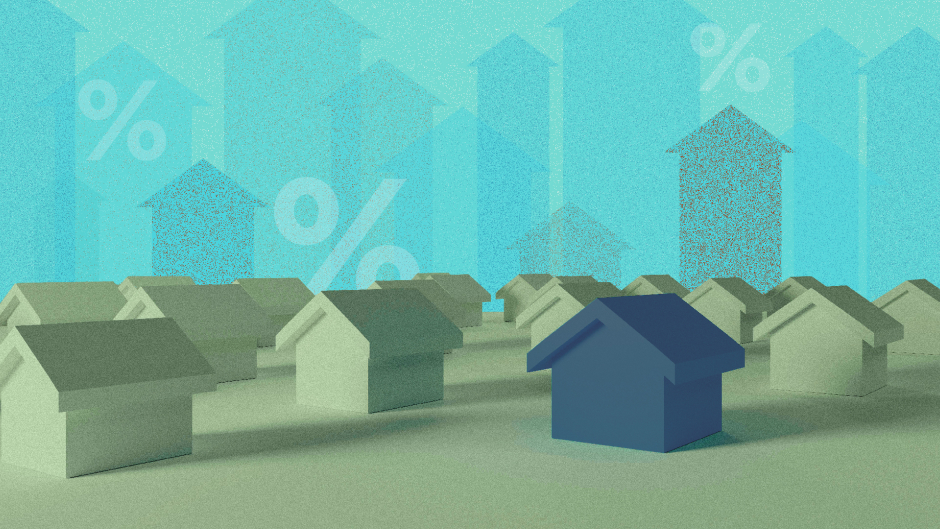Latest Content > What Homeowners can do During High Inflation Coupled with Rising Interest Rates
What Homeowners can do During High Inflation Coupled with Rising Interest Rates

A worldwide pandemic, rising inflation, supply chain disruption, and war in Europe has the world economy heading for a recession. Leading into this current economic cycle, US home values rose at record pace, increasing by more than 20% year of year in March. As a result, US homeowner equity has risen to record a record level at $27.8 Trillion. The vast majority of American homeowners can now access new untapped wealth and put it to use. How you access that capital can have serious financial implications.
We’ll discuss the impact of inflation rising interest rates and how it impacts homeowners, and what solutions are available for you.
How does inflation impact the economy and prices?
Inflation is healthy, as long as it is contained. A slightly positive inflation rate drives our economic engine by contributing to price stability and employment. Since 1914, the average inflation rate has been 3.27%. In recent years, the Fed has targeted a 2% annual inflation rate. However, experts predict that inflation will be 8% in 2022. A sharp increase in inflation like this is unsustainable and excessive. It increases the consumer’s cost of living and erodes buying power.
The impact of inflation on everyday consumers is demonstrated by the year over year price increases shown below:

|
|
What is the Federal Reserve doing in response to inflation?
A key mandate of the Federal Reserve is to maintain price stability. In light of the recent spike in inflation, the Fed has adopted monetary policies to drive down inflation. In order to suppress price inflation, the Fed has historically raised the federal funds rates, which is the underlying interest rate impacting consumer and commercial loans. In the 1980s, Fed Chairman Paul Volcker increased the federal funds rate to unprecedented levels, reaching a peak of 14.6% in July 1981. Again in 2006, the Fed increased rates as high as 5.25% before the subsequent market crash. These hikes bleed into the broader economy and drive up rates for mortgages, car loans, and even interest rates on credit card debt. As a result of interest rate increases, demand is suppressed, supply increases, and prices drop as inflation subsides. The risk of increasing interest rates and suppressing demand is that it can trigger a recessionary shift in economic conditions.
Following precedent, the current chairman of the Fed, Jerome Powell, has initiated a series of interest rate hikes to suppress spiking inflation. In March, the Fed approved a 0.25% rate hike followed by an additional 0.50% rate hike in May. In June, the Fed raised interest rates by 0.75% which signals the biggest hike in 28 years. Powell predicts several more hikes before 2022 ends.
Consumers are impacted by rising interest rates in different ways:
 Households with high credit card debt will see their interest rates increase making it harder to pay down debt balances.
Households with high credit card debt will see their interest rates increase making it harder to pay down debt balances.
 Homeowners with variable interest rate mortgages face rapidly increasing mortgage payments.
Homeowners with variable interest rate mortgages face rapidly increasing mortgage payments.
 Values of stocks and bonds tend to decrease as the value of future cash flows are discounted more heavily by investors. This negatively impacts all investors but also retirees.
Values of stocks and bonds tend to decrease as the value of future cash flows are discounted more heavily by investors. This negatively impacts all investors but also retirees.
 Consumers with low or fixed incomes use a higher percentage of their income to pay for necessities like food and shelter. As a result, increases in food prices or shelter prices have a more severe impact on their quality of life when compared to people with higher incomes.
Consumers with low or fixed incomes use a higher percentage of their income to pay for necessities like food and shelter. As a result, increases in food prices or shelter prices have a more severe impact on their quality of life when compared to people with higher incomes.
Real estate as an inflation hedge
Historically, property values hedge well against inflation. However, during periods of inflation, there are homeowners who fare well and those that do not.
As mentioned above, homeowners with variable interest rate mortgages (also known as ARM - Adjustable Rate Mortgages) are at risk. Rising interest rates will cause the interest rates on homeowners’ mortgages or HELOCs to spike. For many, exiting these types of financial arrangements should be a priority.
Those with a fixed-rate mortgage benefit from inflation because the value of their monthly mortgage payments will decrease over time. For example, with a $1500 monthly payment what you agreed to pay your bank for 30 years was worth more five years ago than it is today. However, fixed-rates are termed over the life of the mortgage which can range for periods up to 30 years. That’s a long time to be paying a bank compounding interest. A 20 year term at 5.125% for a loan amount of $272,000 will total $163,339. Imagine what you could otherwise do with that money.

Accelerating inflation is a major concern for seniors. A survey conducted by the American Advisors Group with 1,500 participants, ages 60-75 shows:
|
|
|
|
|
The numbers don’t lie. For older homeowners an increase in their mortgage APR coupled with declining purchasing power adds to an already hefty financial burden.
That’s why it’s no surprise so many senior homeowners choose reverse mortgages or take the painful path and exit through the sale of their family home.
But is that the right thing to do?
Opportunity - what solutions are available if you wish to access your equity?
With homes attaining extremely healthy values, it’s logical to take advantage of it. Some do it to pay down debts because they want to live debt-free while some want retirement funding, or to accomplish financial investment goals. Generally speaking, most homeowners do so for these reasons:
 Live life - travel, start a business, and more.
Live life - travel, start a business, and more.
 Age in place - live comfortably in the community you love without a mortgage payment hanging over your head.
Age in place - live comfortably in the community you love without a mortgage payment hanging over your head.
 Unexpected expenses - sudden health issues, financial aid to family, house repairs and modifications, and other surprises.
Unexpected expenses - sudden health issues, financial aid to family, house repairs and modifications, and other surprises.
 Build wealth - cash in the increase in your home’s value and invest the money elsewhere (i.e. diversify their real estate holding from one home to equity in others).
Build wealth - cash in the increase in your home’s value and invest the money elsewhere (i.e. diversify their real estate holding from one home to equity in others).
And if you’re considering doing that, these solutions are available to you:
 Home equity loans. The most commonly used way to access equity. However, most interest rates on home loans, HELOCs (a home equity line of credit), and cash-out refinancings can change frequently because they are affected by the Fed's interest rate hikes. So they’re not the best option in times of uncertainty and if you want to remain debt-free these are not for you.
Home equity loans. The most commonly used way to access equity. However, most interest rates on home loans, HELOCs (a home equity line of credit), and cash-out refinancings can change frequently because they are affected by the Fed's interest rate hikes. So they’re not the best option in times of uncertainty and if you want to remain debt-free these are not for you.
 Reverse mortgage. A reverse mortgage is a mortgage loan, secured by a residential property, that enables the borrower to access the unencumbered value of the property. The loans are promoted to older homeowners and typically do not require monthly mortgage payments. However, mortgage interest just accrues each month with the bill coming due when the homeowners sell or pass away. In addition, 40% of reverse mortgages are used to pay off remaining mortgages, and they entail hidden costs like lender & origination fees, FHA insurance charges, and closing costs. Of course, you can add these fees into the loan balance, but that means you’re agreeing to more debt for less equity.
Reverse mortgage. A reverse mortgage is a mortgage loan, secured by a residential property, that enables the borrower to access the unencumbered value of the property. The loans are promoted to older homeowners and typically do not require monthly mortgage payments. However, mortgage interest just accrues each month with the bill coming due when the homeowners sell or pass away. In addition, 40% of reverse mortgages are used to pay off remaining mortgages, and they entail hidden costs like lender & origination fees, FHA insurance charges, and closing costs. Of course, you can add these fees into the loan balance, but that means you’re agreeing to more debt for less equity.
 Selling and moving. Moving out of the family home is a difficult choice. For many seniors, it means leaving the community you love and moving further from loved ones. Ideally you are able to profit off the sale of your home and buy affordably in another area.
Selling and moving. Moving out of the family home is a difficult choice. For many seniors, it means leaving the community you love and moving further from loved ones. Ideally you are able to profit off the sale of your home and buy affordably in another area.
 Home equity sharing solutions. These let you access cash fast. Give a portion of your home equity in exchange for a percentage of the future value of your house. But watch out because not all offers are created equal. Companies offering home equity solutions are most often structured as term loans. In other words, a wolf in sheep’s clothing. For example, some home equity solutions will have 10 year term limits where you are forced to sell your home or pay back the value of your home. Other solutions will estimate your house 20% below market to mitigate their risk and take a 2.5% fee while forcing you to buy them out after 30 years. Ironically, at that point many suggest you would be forced to get a loan, use savings, or sell the property and move. Essentially, taking you back to square one while they cash out and walk away.
Home equity sharing solutions. These let you access cash fast. Give a portion of your home equity in exchange for a percentage of the future value of your house. But watch out because not all offers are created equal. Companies offering home equity solutions are most often structured as term loans. In other words, a wolf in sheep’s clothing. For example, some home equity solutions will have 10 year term limits where you are forced to sell your home or pay back the value of your home. Other solutions will estimate your house 20% below market to mitigate their risk and take a 2.5% fee while forcing you to buy them out after 30 years. Ironically, at that point many suggest you would be forced to get a loan, use savings, or sell the property and move. Essentially, taking you back to square one while they cash out and walk away.
How is Vesta Equity different?
Our solution approaches this with the idea that successful relationships create a win-win for parties:
 No borrowing, interest, or payments.
No borrowing, interest, or payments.
 No forced, contractual downward adjustment on the valuation of the property.
No forced, contractual downward adjustment on the valuation of the property.
 You won’t have to give up any of your rights or forfeit power of attorney that would normally allow investors to act on your behalf.
You won’t have to give up any of your rights or forfeit power of attorney that would normally allow investors to act on your behalf.
 In events of death or succession, you can pass down the house to your family without any financing to settle.
In events of death or succession, you can pass down the house to your family without any financing to settle.
What if you could leverage the value of your property to your advantage and not the bank’s?
Now you can. We simply provide the solution and with us you are in the driver's seat managing your equity to define your ideal prosperity.
Sign up to get alerts about new posts
What’s New

Vesta Equity Market Recap 19.0
Stay informed and make informed decisions with Vesta Equity's Real Equity Marketplace Update 19.0, foreseeing trends.
 Read Blog
Read Blog

 Coffee (lb.) +16%
Coffee (lb.) +16% Bacon (lb.) +23%
Bacon (lb.) +23% Eggs (dozen) +26%
Eggs (dozen) +26% Gasoline (gallon) +51%
Gasoline (gallon) +51% Heating oil price (average home) +79%
Heating oil price (average home) +79%